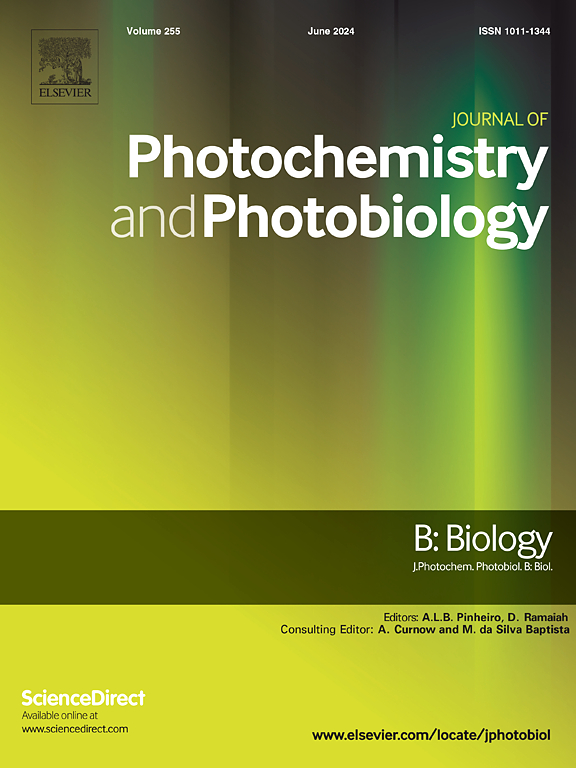Comparative efficacy and safety of traditional single-shot and two successive pass and diascopy method in Q-switched Nd: YAG laser-assisted tattoo removal: an evaluator-blinded trial
IF 3.7
2区 生物学
Q2 BIOCHEMISTRY & MOLECULAR BIOLOGY
Journal of photochemistry and photobiology. B, Biology
Pub Date : 2025-10-14
DOI:10.1016/j.jphotobiol.2025.113283
引用次数: 0
Abstract
Background
Various methods for tattoo removal have been employed over the last century, including different methods of laser treatment.
Aim
To compare three different methods of Q-switched laser treatment.
Methods
A prospective, comparative cohort study was carried out on 17 subjects with tattoos. Each tattoo was segmented into three sections. The first part underwent a single application of the with QS Nd:YAG. The second part received two pass of QS Nd:YAG treatment with a 15-min interval at each session. The third part received a laser treatment with a 4 mm thick silicone blade on the skin (diascopy).
Results
The study included 17 participants aged 18 to 37 years, with an average age of 26.41 ± 9.64 years. Males represented 94.1 % (n = 16) of the sample, while females accounted for 5.9 % (n = 1). The highest clearance degree was achieved by two-shot laser method (3.47 ± 0.68), followed by one-shot laser method (2.72 ± 0.62) and diascopy method (2.45 ± 0.86). Although the clearance degree of two-shot method was significantly higher than one-shot method (P value: 0.014), one-shot and diascopy methods did not show any significant difference in this regard (P value: 0.11). There was no significant difference between mean pain severity expressed by patients in the three treatment methods. None of the patients showed any side effects after treatment.
Conclusion
We found that using two passes of laser treatment in one session enhanced the clinical efficacy, with comparable safety profile to standard one-shot method or diascopy method.
q开关Nd: YAG激光辅助纹身去除的传统单次和两次连续传递和复制方法的疗效和安全性比较:一项评估者盲法试验。
背景:在上个世纪,人们采用了多种方法去除纹身,包括不同的激光治疗方法。目的比较三种不同的调q激光治疗方法。方法:对17名纹身者进行前瞻性、比较队列研究。每个纹身被分成三个部分。第一部分进行了qsnd:YAG的单次应用。第二组接受两组QS Nd:YAG治疗,每组间隔15分钟。第三部分接受激光治疗,在皮肤上使用4毫米厚的硅胶刀片(diascopy)。结果:纳入17例患者,年龄18 ~ 37岁,平均年龄26.41±9.64岁。男性占94.1% (n = 16),女性占5.9% (n = 1)。两次激光法获得的清除率最高(3.47±0.68),其次是一次激光法(2.72±0.62)和一体机法(2.45±0.86)。虽然两针法的清除程度显著高于一针法(P值:0.014),但一针法与一体机法在这方面没有显著差异(P值:0.11)。三种治疗方法患者表达的平均疼痛严重程度差异无统计学意义。所有患者治疗后均未出现任何副作用。结论:我们发现在一个疗程中使用两道激光治疗可提高临床疗效,其安全性与标准的一次注射方法或一体式手术方法相当。
本文章由计算机程序翻译,如有差异,请以英文原文为准。
求助全文
约1分钟内获得全文
求助全文
来源期刊
CiteScore
12.10
自引率
1.90%
发文量
161
审稿时长
37 days
期刊介绍:
The Journal of Photochemistry and Photobiology B: Biology provides a forum for the publication of papers relating to the various aspects of photobiology, as well as a means for communication in this multidisciplinary field.
The scope includes:
- Bioluminescence
- Chronobiology
- DNA repair
- Environmental photobiology
- Nanotechnology in photobiology
- Photocarcinogenesis
- Photochemistry of biomolecules
- Photodynamic therapy
- Photomedicine
- Photomorphogenesis
- Photomovement
- Photoreception
- Photosensitization
- Photosynthesis
- Phototechnology
- Spectroscopy of biological systems
- UV and visible radiation effects and vision.

 求助内容:
求助内容: 应助结果提醒方式:
应助结果提醒方式:


